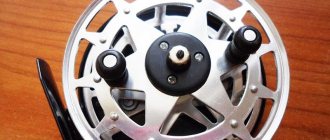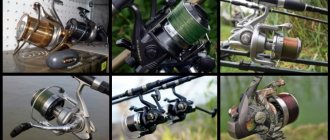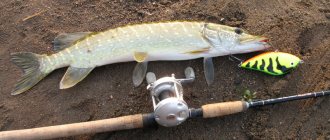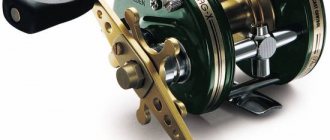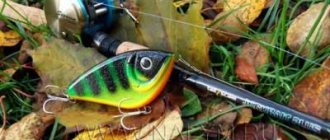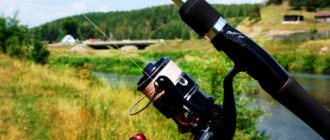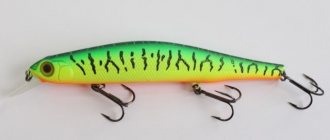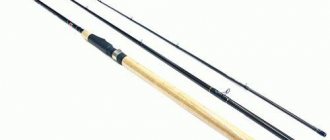The best manufacturers of feeder reels - which company to choose
The best fishing tackle, including reels, combining optimal quality parameters and high technology, is produced in Japan; products from European manufacturers are also deservedly popular.
We recommend paying attention to the following brands of coils:
- Daiwa;
- Shimano;
- Ryobi;
- Mikado;
- Abu Garcia.
Those wishing to understand the intricacies of choosing a feeder coil will be helped by an overview of their varieties, advantages and disadvantages.
Recommendations: 12 Best Metal Detectors
14 best fishing rods
15 best gas trimmers
Selecting a spare coil
Many anglers have encountered the problem of a reel breaking while fishing. Because of this, purchasing a spare coil is mandatory. The spare coil should be selected in the same way as the main one. If material possibilities allow, you can purchase two identical coils or coils with the same characteristics (later you can compare them to find out which one was better).
If funds to purchase a spare coil are limited, you should choose a cheap model. The only important requirement is the same spool size . This will allow, if the spool itself breaks, to leave the reel in place and replace the spool with a spare one.
Selecting a feeder reel is a rather complex process, since many different factors must be taken into account, ranging from the price category of the product to technical characteristics. Compliance with all the rules and recommendations described above will certainly help you purchase a high-quality feeder reel and ensure your success in fishing.
Types of reels for feeder fishing
Spinning
They are often used to equip a feeder rod. Among the spinning reels, the easiest way is to select the required model, focusing on the gear ratio that is optimal for feeder fishing (4.8:1, 5.0:1). Most spinning reels meet the requirements of bottom fishing.
Advantages:
- Versatility of use;
- Sufficient power of the reel makes it possible to catch a large trophy during fishing;
Flaws:
- Feeder fishing creates more difficult operating conditions for a spinning reel than those for which it is designed. This shortens its service life;
- The spools of spinning reels, as a rule, have a significant depth, which requires the use of winding.
Match
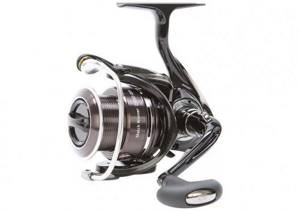
This type of spinning reel is the best option for feeder fishing. Match reels are designed for long-distance casting.
Reels of this type are characterized by a low-profile spool geometry - it is shallow, with a low side. The required capacity of the spool is provided by its width. As a rule, manufacturers include the Match marking in the name of match reels.
Advantages:
- Optimal spool depth, allowing the use of thin line without winding the backing;
- The specific geometry of the spool and low profile make it easier to dump the line, while the friction of the line on the side is minimal, which increases the casting distance of the tackle;
- The rear clutch allows you to effectively change the force on the line when fishing for large fish, and allows you to quickly change spools;
- As a rule, they are equipped with two spare spools, which allows you to use several types of fishing line, adapting to the fishing circumstances. The spools included with one reel can be of different depths.
Flaws:
- They are inferior in power to spinning reels and cannot be used with heavy feeders;
- The rear drag makes the reel bulkier;
- The specific geometry of the reel requires extremely high-quality winding, otherwise a thin fishing line or braided cord will form loops and knots when casting.
Carp
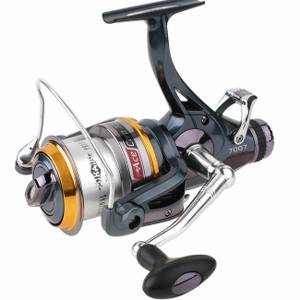
Carp reels are the largest, usually with a spool size of 5000 or more. The main feature of the carp reel is the baitrunner; thanks to this option, even large carp will not pull the rod off the stand during an energetic bite.
A baitrunner is a mechanical system for releasing line when the line guide is closed; it turns off the friction brake, allowing the line to freely come off the spool. The baitrunner is turned off manually using a bracket or by turning the reel handle.
Advantages:
- Reliability;
- Makes it possible to loosen the clutch with one movement of the lever and prevent line breakage, damage and loss of the fishing rod in case a large fish suddenly pulls;
- It can also signal a bite at the moment the line is released by emitting a characteristic crackling sound;
Flaws:
- The presence of a baitrunner increases the cost of the reel.
Bayrunner
This element of a spinning reel is, first of all, important for carp anglers, but it is also useful in feeder fishing. The essence of the baitrunner is that with one movement of the lever you loosen the clutch, which is very necessary when catching large and fast fish such as carp and carp. If the clutch is too tight, a large fish can simply drag your rod away.
But if you have a baitrunner turned on, then the line will come off as if it were on a regular drag. But then what is the difference between a regular clutch, you ask. The thing is that the baitrunner works instantly, and the time needed to turn it on/off is much less than when unscrewing the clutch. The baitrunner bracket is often located at the back of the reel.
After installing the rod on the stand, the baitrunner is turned on, and before hooking, the baitrunner is turned off. You can turn off the baitrunner either by turning the reel handle or by using a bracket. The baitrunner, like the clutch, can be adjusted (softer/harder). The baitrunner will not only preserve your feeder gear, it is also a good signaling device, as it makes a loud frictional sound when the fishing line is released.
When bitten, a large fish will begin to reel in the fishing line until the fisherman turns off the baitrunner, after which the friction brake begins to work.
Feeder coil selection parameters
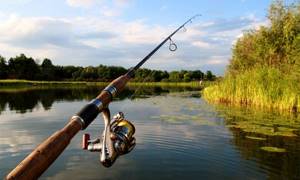
Spool (reel) size
Fishing with a feeder involves long-distance casting of equipment (from 25 to 100 meters). After casting, it should be possible to quickly reel the line out of the water, so a reel size as large as possible is desirable. The large reel effectively reels out the fishing line; it contains a fairly powerful mechanism that can withstand heavy loads.
The reel size designation indicates the ability to hold 100 meters of fishing line of a certain diameter on the spool. Thus, a spool marked “2000” holds 100 meters of fishing line with a diameter of 0.2 mm, and a spool “3000” holds 100 meters with a diameter of 0.3 mm. For the feeder, coils with a size of 3000-4000 are used (even up to 8000, but not less than 2500).
Number of spools included
Some reel models may include several spools. Not all brands and not all types of reels are equipped with two or more spools. When purchasing a reel, it makes sense to pay attention to this. This allows you to use different equipment by changing the spool with braided line to a spool with monofilament line.
Spool type
It is preferable to use a shallow spool with a low profile - the lower the line is laid on the reel, the easier it will be to cast.
Low-profile models eliminate the need to prepare backing for the working line; if it is laid correctly, the side of the spool should protrude no more than 2-3 mm. Otherwise, when casting, the fishing line clings to the spool profile, the friction force holds it back, and the equipment will not reach the intended target.
Spool shape
Since most feeder rigs use braided line, it is preferable to use a reverse taper spool. Thanks to this shape, during casting the line will not fly off in whole turns, saving the tackle from getting tangled.
Gear ratio
The gear ratio is the ratio of one revolution of the handle to the number of revolutions of the line guide around the spool (accurate to decimals). It is indicated on the reel body (for example, 4.0:1 or 5.6:1).
According to this parameter, coils are divided into power and speed. If the first indicator is less than five, the coil is classified as power. High-speed reels include those whose line guide makes more than five revolutions around the spool per revolution of the handle.
The feeder requires a power coil. The best purchase options would be reels with a line layer speed of 4.6 to 5.2.
Line laying quality
It is important for a reel in feeder fishing. It is better provided by models equipped with a so-called endless screw. If there is a kind of longitudinal bulge on the back of the coil, then it is included in the design. You can also see information about the features of the coil in the technical description.
Reel weight
A comfortable reel weight for a standard fishing rod is 300-350 grams. For a picker rod, which belongs to the light class, the weight of the reel is 240-250 grams. For Heavy class rods (for fishing in rivers with medium and strong currents), a reel weighing 400-450 grams can be used.
Number of bearings
A reel designed for more than one season of use should have four to five bearings or more. Too many bearings make the reel heavier, so you shouldn’t bother with too many of them.
For feeder gear, it is fundamentally important to have four bearings in the reel:
1. Roller in the line layer;
2. Two support in the handle;
3. Rotary on the main rod.
Friction clutch
It is necessary for releasing the line from the reel with active resistance from the fish. Large prey can stretch the line or break the tackle. The drag, adjusted to a certain load, “allows” the fish to pull the line off the reel during strong jerks.
During periods when the prey calms down and stops resisting, it is pulled up, gradually bringing it closer to the surface of the water. Without a friction clutch, it will not be possible to deplete her strength. The friction brake can be located at the rear or at the front of the reel. Each type has its pros and cons.
1. Front clutch - adjusted by rotating the screw, which also serves as a spool mount. It is more convenient to use ultra-light gear.
2. Rear drag - more convenient when used in more powerful gear designed for larger fish.
3. Baitrunner - it is equipped with reels designed for catching large fish (most often carp reels have it). Accordingly, their use is advisable on carp rods.
Feeder Concept Pilot
This feeder reel was developed at the beginning of 2021, and is the most modern among all in our rating. I'm especially pleased with the design of the reel; it looks simply amazing. Models available in sizes 3000, 4000, 5000.
The reel has good traction characteristics, smooth running, and low weight. Aluminum spool coated with titanium and nickel, 7 ball bearings, carbon fiber body, very rigid rotor. Included with the main spool is the same additional one, with a shallow profile, which allows you to do without backing.
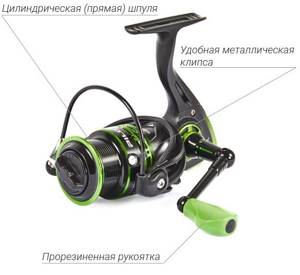
- Size 3000 goes well with pickers and light feeders up to 3 meters long. The recommended throwing weight of weights and feeders is up to 80 grams.
- Size 4000 is suitable for medium-length feeders up to 3.6 meters long. Recommended throwing weight is up to 120 grams.
- Size 5000 for long-distance feeders up to 4.5 meters long. Recommended throwing weight is up to 180 grams.
Feeder Concept Pilot 7 is a very cool feeder reel and has all the necessary characteristics for feeder fishing. The price/quality ratio is excellent, and no problems were identified at all. So it takes a worthy first place in our rating, as I really liked it. If I have the opportunity, I will most likely buy it. Feeder Concept price – 3700 rub.
Which feeder reel to choose?
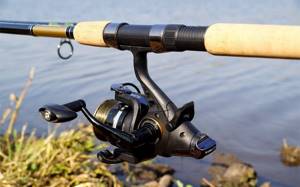
1. For picker rods and middle-class (medium) rods, reels with a spool size of 2500-3500 are suitable;
2. For Medium and Heavy class rods, you can use a reel with a spool size of 4000;
3. For long-distance fishing and carp fishing, where Heavy and Extra Heavy rods are used, reels with 5000 and 5500 spools are suitable;
4. It is preferable to choose a reel with a rear drag; fishing with a reel of this design is more convenient;
5. Beginners who like feeder fishing can be recommended to purchase inexpensive models of different types (for example, match and spinning). This will give you the opportunity to get comfortable, then choose the most suitable and convenient option for yourself;
6. Beginners should not pay much attention to the number of bearings in the reel; to master a new type of fishing, it is enough to purchase a budget reel with four bearings.
Reel rating
Of all the fishing gear for feeder fishing, perhaps reels are the most widely represented and best described, both by sellers and buyers. Many people share their opinions about the advantages and disadvantages of certain devices in social network groups or on already archaic forums.
Also, a lot of information about the advantages and disadvantages of a particular type of product can be gleaned from customer reviews on trading platforms (such as Yandex.Market in the Russian Federation or Rozetka in Ukraine, etc.).
In addition, due to fierce competition, the marketing departments of all manufacturers of feeder reels have long established feedback channels with customers and successfully monitor all changes in the tastes and preferences of fishing enthusiasts.
Based on data from both sides of commodity-money relations, it is possible to make a rating of the most popular goods in a given category. Methods for such assessment may be different, the main thing is that they take into account all the main parameters of the coil:
- correct functioning;
- strength and reliability of the structure;
- ease of use;
- completeness of delivery.
Well, and, of course, do not forget such an important parameter as price.
The table below shows the rating of the 10 best feeder reels for mid-2021, expressed in points on a ten-point scale.
| product name | Rating |
| Stinger Forceage Neo 3000 | 9.0 |
| Daiwa Laguna E 3000b | 9.1 |
| Okuma Inspira Isx-30r | 9.2 |
| Volzhanka Meteor 3000 | 9.2 |
| Shimano Stradic Ci4+ C3000 Fb | 9.3 |
| Ryobi Arctica 4000 | 9.4 |
| Salmo Elite Baitfeeder 7 4000br | 9.6 |
| Daiwa Fuego 4000d-C Lt (17) | 9.7 |
| Shimano 17 Ultegra C3000 Fb | 9.8 |
| Ryobi Excia Mx 3000 | 9.8 |
Reel spool depth when fishing with a feeder
This indicator is no less important than the quality of the material. Deep reels use a line of large diameter and length, although they have the problem of friction when the line comes off. A deep spool without backing has difficult line retraction, which negatively affects the possible casting distance.
Read more
Feeder Rigging Basics for Beginners
Shallow and fairly long spools with a high forest capacity, the so-called “Long Cast,” are popular among feeders. They do not require backing, have good laying and uniform winding of the fishing line, a fairly high casting range and are used when fishing with thin cords.
Number of bearings for reel
Any model of a spinning reel has rotating and rubbing parts. In order to extend their service life, bearings are installed in the reel. In addition to reducing friction, they make the reel run smoother. Many people believe that the more bearings the better, their number can reach 15 pieces. A reel that has at least 4 bearings can be used to fish with a sufficient level of comfort. The most popular among feeder fishing enthusiasts are models whose design includes 5-6 bearings.
Read more
What is an anti-twist for a feeder?
